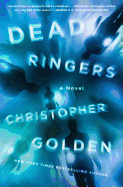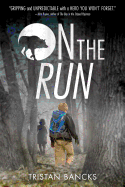 |
| Will Staehle |
|
 |
| Tania del Rio |
|
The image of Warren--a smallish, toad-faced boy with beautiful hair--appeared to designer and illustrator Will Staehle one day when he was in college. Even when Will's friend and fellow student Tania del Rio first saw the funny little character, she knew she wanted to write a story about him. More than a decade later, the creative team is excited to share their longtime collaboration and middle-grade series debut, Warren the 13th and the All-Seeing Eye (Quirk Books, November 24, 2015), with the rest of the world.
Where did Warren come from, Will?
I created Warren back in college, over 13 years ago now, at MCAD, the Minneapolis College of Art and Design. Warren was always a bellhop at a Victorian hotel. I had a dream--it just popped into my head--of this sort of toadlike boy. I did a drawing of him, and he's pretty much stayed unchanged ever since. There's a little bit of Little Lord Fauntleroy in Warren. Sure, people look at him a little differently, but at least he has great hair.
Tania, when did you first lay eyes on the toad-faced Warren?
Will and I studied comic illustration together at MCAD, and he had created a poster for a comic-book class--it was a picture of Warren in the hotel boiler room with the monster Sketchy (before we named him Sketchy). I remember being instantly attracted to the image. He was such a weird-looking kid but he had a very cute hairstyle and golden curls, and that burned itself into my mind. He was definitely very inspiring. I wanted to write a kids' prose book about him, like something by Roald Dahl.
Will, did you always imagine Warren to be such a good-hearted, conscientious soul?
I think maybe in the very first drawing he might have been a little more of a troublemaker, with a little more of a Bart Simpson vibe, but that went away pretty quickly. It didn't feel right for the character.
How about you, Tania? Did you always imagine Warren as the stoic, hardworking sort?
Yes. You hear a lot about kids trying to avoid chores or responsibility, so I thought it would be a really fun twist that he would not only enjoy doing chores at the hotel, but he'd take great pride in his work... and even have a noble reason to do that because he wants to live up to his father's name.
Will, who is your favorite character?
I'd have to say Warren. So boring, I know! But I do have quite a soft spot for Rupert, too. I've always loved oblivious characters who add a punch of humor to the overall story.
Who is your favorite character in the book, Tania?
That's a tough one. I have to say it's Warren just because he is so sweet, hardworking and well-intentioned. He's also the character I've been working with the longest. But more recently, I've become a fan of Petula. I like the contrast she brings to Warren and I wanted to create a girl character who wasn't a typical know-it-all, or the girl who always cautions the boy not to get into trouble. She gets into a bit of trouble herself and has a dark streak. I enjoyed writing her.

Tania, you studied illustration and animation in college. Have you always been interested in writing as well?
Yes, absolutely. Storytelling in general, with art or words. As I get older I get more satisfaction from writing than I do from art. Writing is the uncharted territory where I can spread my wings a little bit more. I've had a journal since I was eight years old. I have trunks of journals, some of them so horrible I can't even look at them.
Do you think that your years of writing Sabrina the Teenage Witch rubbed off on Warren the 13th? Or, I should say, on Aunt Annaconda?
I really like the concept of witches in general--both the classic Hollywood and pagan versions, but it's the classic Hollywood version in Warren, and more of Wicca in Sabrina. I like the mysterious aspect of the archetype. I love playing with what challenges witches--what horrible things they can do, but also what great things they can do. That showed up a lot in Sabrina. Roald Dahl influenced me as well, as did the wise women characters in Miyazaki films. Magic in general imbues all my work. I just love that kind of vibe.
Tania, tell us about the idea of the All-Seeing Eye. Not that we should give anything away!
It wasn't called the All-Seeing Eye in the beginning, but there was always the notion that there was something secret hidden in the heart of the hotel, something Aunt Annaconda was after. Will and I wanted to have the hunt for treasure and clues and mystery... that's the kind of story we always wanted to tell.
I liked all the clues and puzzles and codes and riddles. There's even a letter you have to hold up to a mirror to read. Will, are you a puzzle person?
Not particularly. I knew that it would be a big part of the book because it's a quest-like story. It just felt right for this project. Some of the puzzles are easy, some are tricky. There are even some secrets hidden in the book's headers!

What about you, Tania?
I have to admit that I am terrible at solving puzzles! That made inventing clever puzzles one of the more challenging aspects of writing Warren. But once I realized that the best way to approach a puzzle is to come up with the solution first and then work your way backwards to create the clues, it became a bit easier.
Will, how did Warren the 13th finally materialize as a book?
Warren just sat there for a long time, and then a couple years ago a buddy I worked with at HarperCollins moved to Philly to become the art director at Quirk. He introduced me to Jason [Rekulak], who's the publisher there, and they published two books of my silhouette postcards. Jason said to come down and meet him at San Diego Comic Con, and to pitch any other ideas I might have, so I presented Warren, and Jason loved it immediately!
How would you describe Warren the 13th--it's not a graphic novel....
We're having trouble with the right terminology for it.
An illustrated novel?
I guess that's it, yeah. I feel like it has more illustrations than most illustrated novels, but....
Maybe a heavily illustrated novel?
Yes. An incredibly time-consuming, heavily illustrated novel! I think we have over 200 illustrations, a little over 200 pages, pretty much an illustration per page, math-wise.
Will, you're the designer. How would you describe the style of the book?
Victorian. I've always been interested in Victorian stuff. My parents are antique collectors, so I grew up in a very eclectic house with big clocks and taxidermy and weird sculptures and lots of paintings of naked people on the walls. My young friends would come over and say, "What is that?" This was Wisconsin. I love Victorian typography, stuff you'd see in dime novels or in newspaper advertisements from the 1890s, when they had these huge pages of ads for things like Dr. Joseph's Hair Tonic. As for the two-column format... it's different. I wasn't sure how people would react. But it's still that Victorian aesthetic, setting it up like newspaper columns.
And how would you describe your artwork?
At the heart of it, it's collage. There are vintage, turn-of-the-century engravings from my personal collection of ephemera, Harper's Weeklys, old magazines and newspapers. Warren and the other characters at the hotel are drawn, and then special effects are applied to give them engraving-style shading. For the hotel, I have a 3D digital model, so I can reuse it and rotate it around and render it. I didn't want to redraw it every single time. Really, it's a mish-mash of a lot of things that I pull together in one, hopefully cohesive, style.
Will we be seeing more of Warren?
Yes! We're planning another Warren book for Halloween 2016. The first two are free-form, stand-alone adventures, but we hope it eventually will be a much longer series of tales.
Will, do you really wear red socks everyday?
Yes! Not the same ones, different ones, but every day. People think it's some kind of amazing, mythical thing but it's pure convenience.
If it were pure convenience, why not white socks?
Well, I guess there's a little bit of style involved. I am a designer, you know, so there is that. --Karin Snelson
 Cats now outnumber dogs in U.S. households, so we'd like to point out five new books, purr-fect gifts for any feline fancier. Men & Cats (Perigee Books, $15) is for those who love to watch Sex and the City with their animal companions. This trim hardcover expands on Marie-Eva Gatuingt and Alice Chaygneaud's popular blog Des Hommes et des Chatons, with b&w photos of cats juxtaposed on the opposite page with scantily clad hunks in the same pose. It's hard to choose which side to cuddle with first. Wildlife photographer Mitsuaki Iwago's oversized hardcover Cats & Lions (Chronicle, $24.95) has a similar layout, with contrasting images of domestic cats opposite lions in the wild.
Cats now outnumber dogs in U.S. households, so we'd like to point out five new books, purr-fect gifts for any feline fancier. Men & Cats (Perigee Books, $15) is for those who love to watch Sex and the City with their animal companions. This trim hardcover expands on Marie-Eva Gatuingt and Alice Chaygneaud's popular blog Des Hommes et des Chatons, with b&w photos of cats juxtaposed on the opposite page with scantily clad hunks in the same pose. It's hard to choose which side to cuddle with first. Wildlife photographer Mitsuaki Iwago's oversized hardcover Cats & Lions (Chronicle, $24.95) has a similar layout, with contrasting images of domestic cats opposite lions in the wild. In Fat Cat Art: Famous Masterpieces Improved by a Ginger Cat with Attitude (Tarcher, $14.95), Russian artist Svetlana Petrova inserts her 22-pound cat, Zarathustra, into classic pieces of art. Amazingly, this is not done through Photoshop. Petrova impressively repaints and adds Zarathustra to more than 130 works of art, ranging from Botticelli and da Vinci to Hopper and Dali. Zarathustra offers pithy and illuminating background notes about each painting. --Kevin Howell, independent reviewer and marketing consultant
In Fat Cat Art: Famous Masterpieces Improved by a Ginger Cat with Attitude (Tarcher, $14.95), Russian artist Svetlana Petrova inserts her 22-pound cat, Zarathustra, into classic pieces of art. Amazingly, this is not done through Photoshop. Petrova impressively repaints and adds Zarathustra to more than 130 works of art, ranging from Botticelli and da Vinci to Hopper and Dali. Zarathustra offers pithy and illuminating background notes about each painting. --Kevin Howell, independent reviewer and marketing consultant











 Gordon Thomas and Max Morgan-Witts immortalized this tragedy in their 1974 book Voyage of the Damned. In 1976, it was made into a film starring, among others, Faye Dunaway, Max von Sydow, Malcolm McDowell and Orson Welles. Skyhorse Publishing reprinted the book in 2010.
Gordon Thomas and Max Morgan-Witts immortalized this tragedy in their 1974 book Voyage of the Damned. In 1976, it was made into a film starring, among others, Faye Dunaway, Max von Sydow, Malcolm McDowell and Orson Welles. Skyhorse Publishing reprinted the book in 2010.










